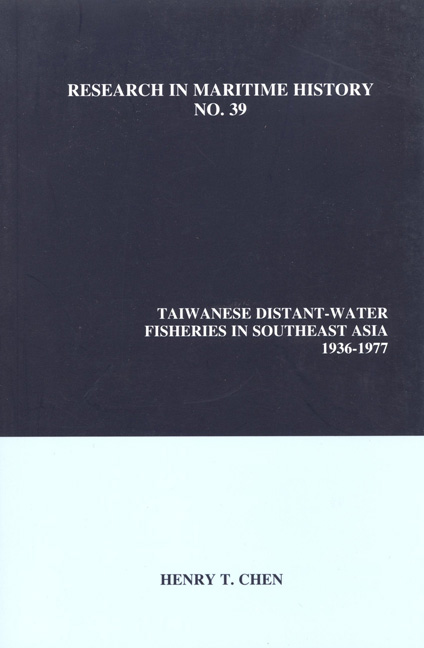Book contents
- Frontmatter
- Contents
- List of Tables
- List of Illustrations
- Notes on the Sources
- About the Author
- Acknowledgements
- Introduction
- Chapter 1 Japan and the Development of Taiwan's Fishing Industry
- Chapter 2 The Revival of the Fishing Industry in Postwar Taiwan
- Chapter 3 Kaohsiung Fishing Port and Its Fishing Ancillary Industries
- Chapter 4 The Taiwanese Fishing Industry and the Military-Political Complex
- Chapter 5 The Kaohsiung Fishing Industry and Its Ancillary Industries
- Chapter 6 The Development of Kaohsiung's Fishing Companies
- Chapter 7 Daily Lives at Sea, Fishing Zones and Politics
- Chapter 8 The Culture and Daily Life of the Kaohsiung Fishing Communities
- Chapter 9 The 1970s Crisis in the Taiwanese Fishing Industry
- Conclusion
- Appendix 1 List of Informants
- Select Bibliography
Chapter 1 - Japan and the Development of Taiwan's Fishing Industry
- Frontmatter
- Contents
- List of Tables
- List of Illustrations
- Notes on the Sources
- About the Author
- Acknowledgements
- Introduction
- Chapter 1 Japan and the Development of Taiwan's Fishing Industry
- Chapter 2 The Revival of the Fishing Industry in Postwar Taiwan
- Chapter 3 Kaohsiung Fishing Port and Its Fishing Ancillary Industries
- Chapter 4 The Taiwanese Fishing Industry and the Military-Political Complex
- Chapter 5 The Kaohsiung Fishing Industry and Its Ancillary Industries
- Chapter 6 The Development of Kaohsiung's Fishing Companies
- Chapter 7 Daily Lives at Sea, Fishing Zones and Politics
- Chapter 8 The Culture and Daily Life of the Kaohsiung Fishing Communities
- Chapter 9 The 1970s Crisis in the Taiwanese Fishing Industry
- Conclusion
- Appendix 1 List of Informants
- Select Bibliography
Summary
Taiwan's modern fishing industry was established during the Japanese colonial period (1895-1945). This initial phase of development featured a spectacular increase in productivity and laid a solid foundation for future activities. The purpose of this chapter is to describe and analyze Japan's influence on Taiwan's fishing industry. Initially, I will answer two important questions: why did the colonial government decide to mould Taiwan into one of the principal forward bases for the fishing industry? And what geographic advantages did Taiwan, especially Takao Port (Kaohsiung), possess for the exploitation of the fishing grounds in Southeast Asia? After examining the roles of Taiwan and Takao in the southward expansion of fishing, I will focus on Japan's contribution to the establishment of the fishing industry in Taiwan from a technical perspective and will discuss the range and diffusion of fishing methods that emanated from Japan and the resulting exploitation of the southern fishing grounds. In the final section of the chapter, I focus on the emergence of Takao's fishing industry, investigate the internal and external conditions of its home port and explain why it surpassed all other regional ports to become the centre of the Japanese fishing industry in Southeast Asia.
Marching Southwards Policy and Nanyo Fisheries
The idea of “Southward Development” [Nanshinron] was first proposed by Japanese intellectuals at the time of the Meiji Restoration. They asserted that since the economies, societies and cultures of Southeast Asia were still underdeveloped, it was Japan's “duty” to control and civilize the region.1 But this mission required an outpost, and Taiwan was viewed as the ideal choice. Prior to the formal annexation of the island in 1895, some Japanese had already foreseen the significance of Taiwan's location as an aid to Japan's southward development. Tokutomi Soho, referred to as the “Guide of the Japanese Empire“ [Teikoku Nihon no Kyodosha], argued that “Taiwan is situated at the southern doorway of our country. If we intend to expand the territory of the Japanese Empire southwards, without a doubt the most important thing we need to do is to control this doorway.“2 He also declared that Japan would have to defend its northern frontier before initiating this southward expansion. With Taiwan as a southern outpost, Japanese influence would be ideally placed to penetrate further into Southeast Asia.
- Type
- Chapter
- Information
- Publisher: Liverpool University PressPrint publication year: 2009



